seats SAAB 9-5 2001 Owners Manual
[x] Cancel search | Manufacturer: SAAB, Model Year: 2001, Model line: 9-5, Model: SAAB 9-5 2001Pages: 272, PDF Size: 14.83 MB
Page 3 of 272
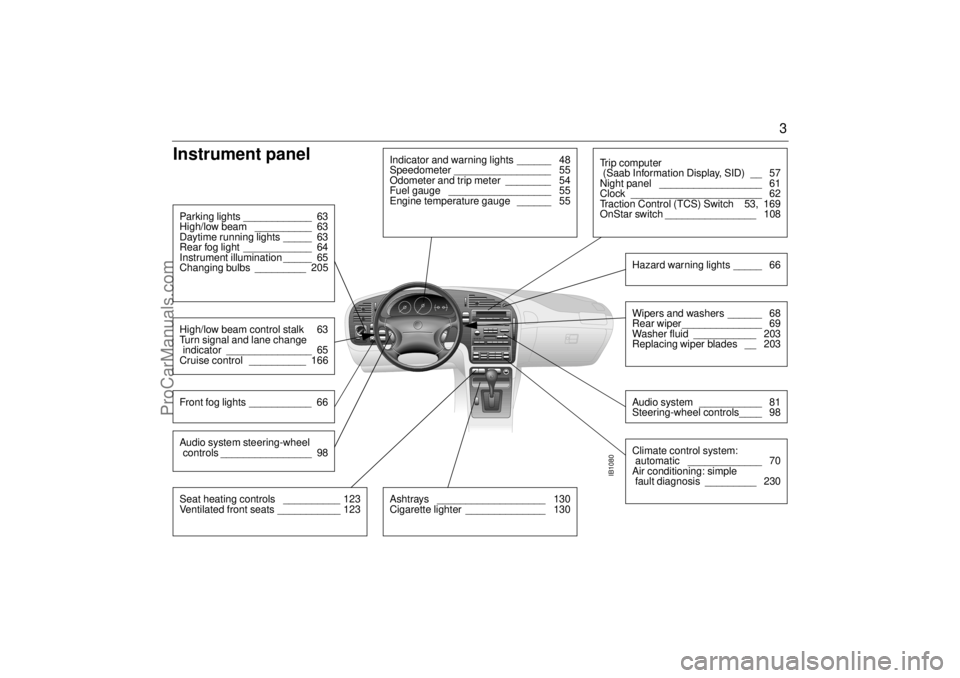
3
Instrument panel
IB1080
Indicator and warning lights ______ 48
Speedometer _________________ 55
Odometer and trip meter ________ 54
Fuel gauge __________________ 55
Engine temperature gauge ______ 55
Parking lights ____________ 63
High/low beam __________ 63
Daytime running lights _____ 63
Rear fog light ____________ 64
Instrument illumination _____ 65
Changing bulbs _________ 205High/low beam control stalk 63
Turn signal and lane change
indicator _______________ 65
Cruise control __________ 166Front fog lights ___________ 66
Ashtrays ___________________ 130
Cigarette lighter ______________ 130
Tr i p c o m p u t e r
(Saab Information Display, SID) __ 57
Night panel __________________ 61
Clock _______________________ 62
Traction Control (TCS) Switch 53, 169
OnStar switch ________________ 108
Wipers and washers ______ 68
Rear wiper ______________ 69
Washer fluid ___________ 203
Replacing wiper blades __ 203Audio system ___________ 81
Steering-wheel controls____ 98Hazard warning lights _____ 66Climate control system:
automatic _____________ 70
Air conditioning: simple
fault diagnosis _________ 230
Seat heating controls __________ 123
Ventilated front seats ___________ 123Audio system steering-wheel
controls ________________ 98
ProCarManuals.com
Page 5 of 272
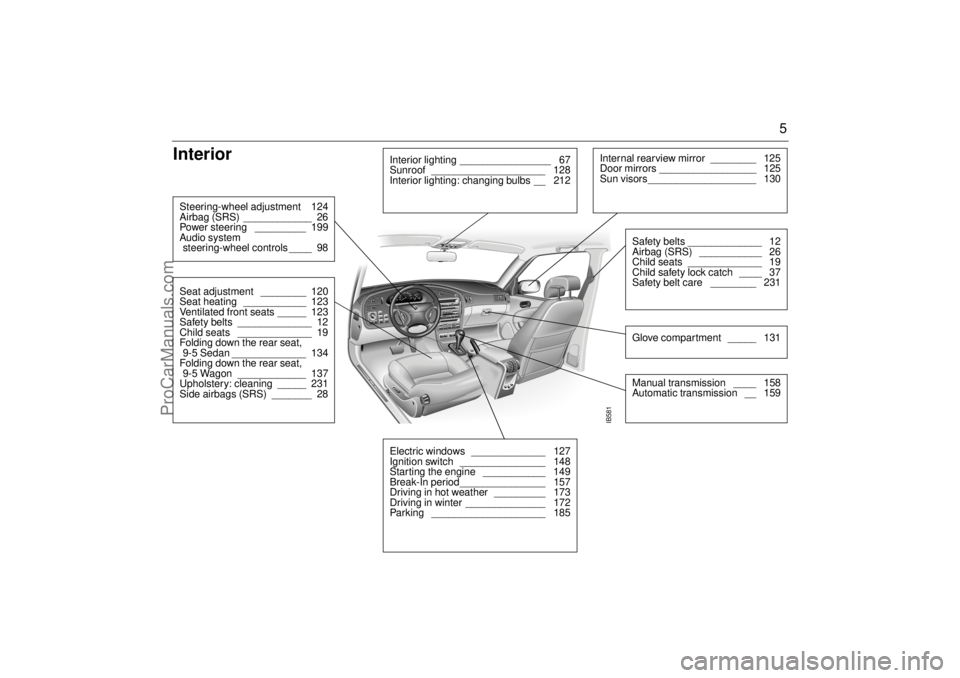
5
Interior
IB581Internal rearview mirror ________ 125
Door mirrors _________________ 125
Sun visors___________________ 130
Safety belts _____________ 12
Airbag (SRS) ___________ 26
Child seats _____________ 19
Child safety lock catch ____ 37
Safety belt care ________ 231Glove compartment _____ 131Manual transmission ____ 158
Automatic transmission __ 159
Electric windows _____________ 127
Ignition switch _______________ 148
Starting the engine ___________ 149
Break-In period_______________ 157
Driving in hot weather _________ 173
Driving in winter ______________ 172
Parking ____________________ 185
Steering-wheel adjustment 124
Airbag (SRS) ____________ 26
Power steering _________ 199
Audio system
steering-wheel controls ____ 98Seat adjustment ________ 120
Seat heating ___________ 123
Ventilated front seats _____ 123
Safety belts _____________ 12
Child seats _____________ 19
Folding down the rear seat,
9-5 Sedan _____________ 134
Folding down the rear seat,
9-5 Wagon ____________ 137
Upholstery: cleaning _____ 231
Side airbags (SRS) _______ 28
Interior lighting ________________ 67
Sunroof ____________________ 128
Interior lighting: changing bulbs __ 212
ProCarManuals.com
Page 12 of 272
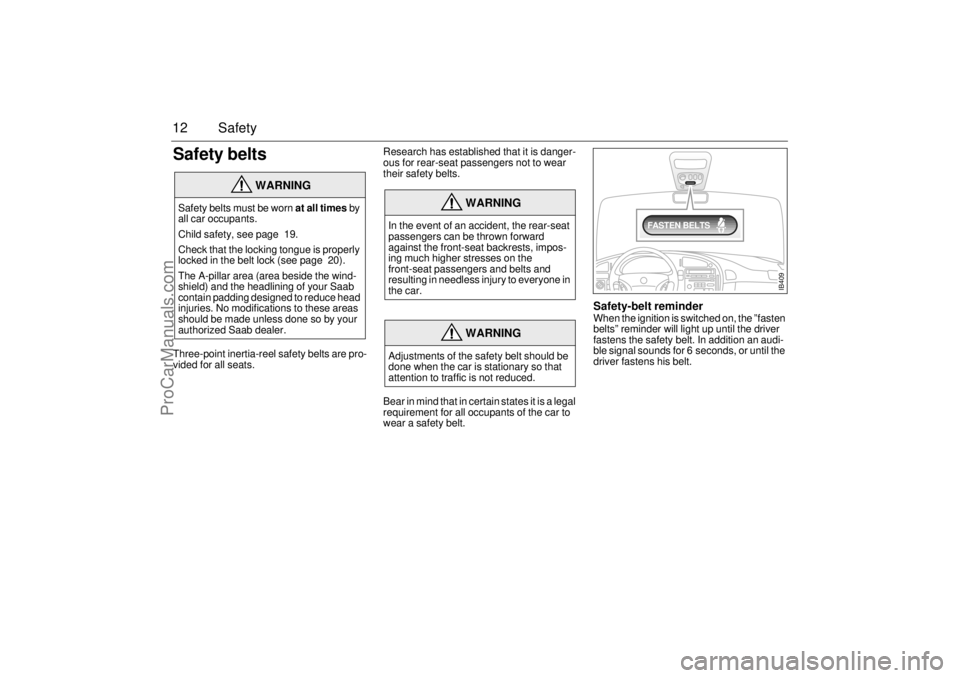
12 SafetySafety belts Three-point inertia-reel safety belts are pro-
vided for all seats. Research has established that it is danger-
ous for rear-seat passengers not to wear
their safety belts.
Bear in mind that in certain states it is a legal
requirement for all occupants of the car to
wear a safety belt.
Safety-belt reminderWhen the ignition is switched on, the ”fasten
belts” reminder will light up until the driver
fastens the safety belt. In addition an audi-
ble signal sounds for 6 seconds, or until the
driver fastens his belt.
WARNING
Safety belts must be worn at all times by
all car occupants.
Child safety, see page 19.
Check that the locking tongue is properly
locked in the belt lock (see page 20).
The A-pillar area (area beside the wind-
shield) and the headlining of your Saab
contain padding designed to reduce head
injuries. No modifications to these areas
should be made unless done so by your
authorized Saab dealer.
WARNING
In the event of an accident, the rear-seat
passengers can be thrown forward
against the front-seat backrests, impos-
ing much higher stresses on the
front-seat passengers and belts and
resulting in needless injury to everyone in
the car.
WARNING
Adjustments of the safety belt should be
done when the car is stationary so that
attention to traffic is not reduced.
IB409
FASTEN BELTS
ProCarManuals.com
Page 13 of 272
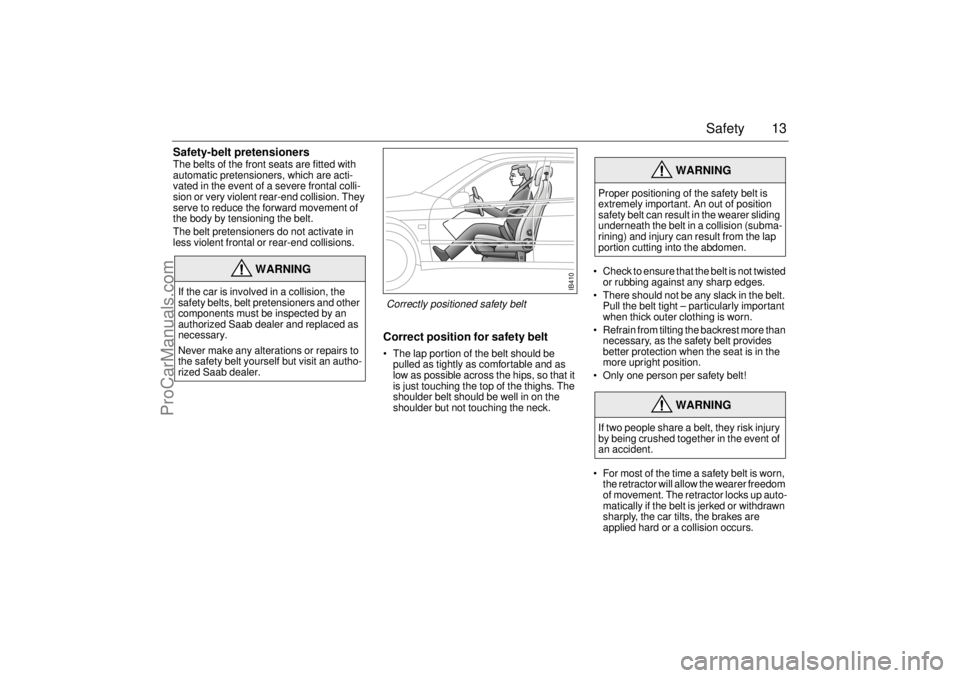
13 Safety
Safety-belt pretensionersThe belts of the front seats are fitted with
automatic pretensioners, which are acti-
vated in the event of a severe frontal colli-
sion or very violent rear-end collision. They
serve to reduce the forward movement of
the body by tensioning the belt.
The belt pretensioners do not activate in
less violent frontal or rear-end collisions.
Correct position for safety belt The lap portion of the belt should be
pulled as tightly as comfortable and as
low as possible across the hips, so that it
is just touching the top of the thighs. The
shoulder belt should be well in on the
shoulder but not touching the neck.
Check to ensure that the belt is not twisted
or rubbing against any sharp edges.
There should not be any slack in the belt.
Pull the belt tight – particularly important
when thick outer clothing is worn.
Refrain from tilting the backrest more than
necessary, as the safety belt provides
better protection when the seat is in the
more upright position.
Only one person per safety belt!
For most of the time a safety belt is worn,
the retractor will allow the wearer freedom
of movement. The retractor locks up auto-
matically if the belt is jerked or withdrawn
sharply, the car tilts, the brakes are
applied hard or a collision occurs.
WARNING
If the car is involved in a collision, the
safety belts, belt pretensioners and other
components must be inspected by an
authorized Saab dealer and replaced as
necessary.
Never make any alterations or repairs to
the safety belt yourself but visit an autho-
rized Saab dealer.
WARNING
Proper positioning of the safety belt is
extremely important. An out of position
safety belt can result in the wearer sliding
underneath the belt in a collision (subma-
rining) and injury can result from the lap
portion cutting into the abdomen.
WARNING
If two people share a belt, they risk injury
by being crushed together in the event of
an accident.
IB410
Correctly positioned safety belt
ProCarManuals.com
Page 18 of 272
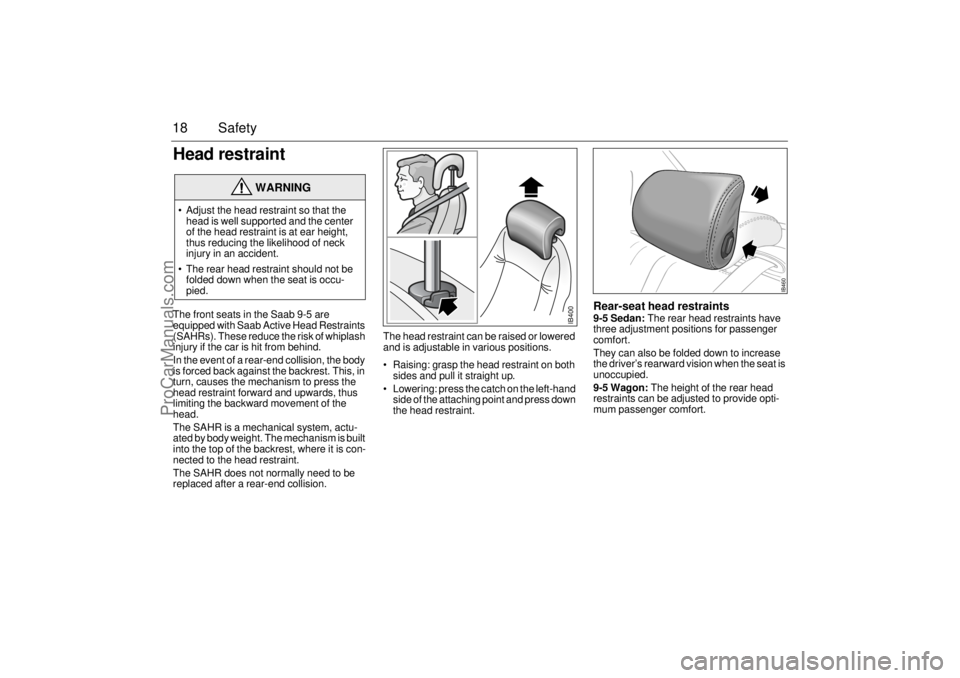
18 SafetyHead restraintThe front seats in the Saab 9-5 are
equipped with Saab Active Head Restraints
(SAHRs). These reduce the risk of whiplash
injury if the car is hit from behind.
In the event of a rear-end collision, the body
is forced back against the backrest. This, in
turn, causes the mechanism to press the
head restraint forward and upwards, thus
limiting the backward movement of the
head.
The SAHR is a mechanical system, actu-
ated by body weight. The mechanism is built
into the top of the backrest, where it is con-
nected to the head restraint.
The SAHR does not normally need to be
replaced after a rear-end collision. The head restraint can be raised or lowered
and is adjustable in various positions.
Raising: grasp the head restraint on both
sides and pull it straight up.
Lowering: press the catch on the left-hand
side of the attaching point and press down
the head restraint.
Rear-seat head restraints9-5 Sedan: The rear head restraints have
three adjustment positions for passenger
comfort.
They can also be folded down to increase
the driver’s rearward vision when the seat is
unoccupied.
9-5 Wagon: The height of the rear head
restraints can be adjusted to provide opti-
mum passenger comfort.
WARNING
Adjust the head restraint so that the
head is well supported and the center
of the head restraint is at ear height,
thus reducing the likelihood of neck
injury in an accident.
The rear head restraint should not be
folded down when the seat is occu-
pied.
IB460
IB400
ProCarManuals.com
Page 19 of 272
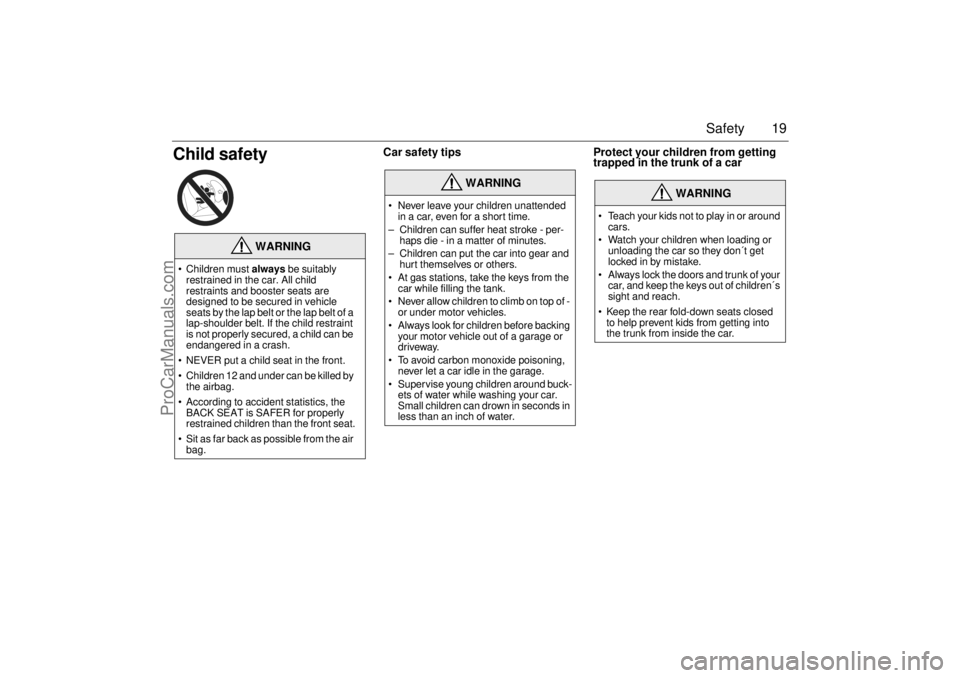
19 Safety
Child safety
Car safety tips Protect your children from getting
trapped in the trunk of a car
WARNING
Children must always be suitably
restrained in the car. All child
restraints and booster seats are
designed to be secured in vehicle
seats by the lap belt or the lap belt of a
lap-shoulder belt. If the child restraint
is not properly secured, a child can be
endangered in a crash.
NEVER put a child seat in the front.
Children 12 and under can be killed by
the airbag.
According to accident statistics, the
BACK SEAT is SAFER for properly
restrained children than the front seat.
Sit as far back as possible from the air
bag.
WARNING
Never leave your children unattended
in a car, even for a short time.
– Children can suffer heat stroke - per-
haps die - in a matter of minutes.
– Children can put the car into gear and
hurt themselves or others.
At gas stations, take the keys from the
car while filling the tank.
Never allow children to climb on top of -
or under motor vehicles.
Always look for children before backing
your motor vehicle out of a garage or
driveway.
To avoid carbon monoxide poisoning,
never let a car idle in the garage.
Supervise young children around buck-
ets of water while washing your car.
Small children can drown in seconds in
less than an inch of water.
WARNING
Teach your kids not to play in or around
cars.
Watch your children when loading or
unloading the car so they don´t get
locked in by mistake.
Always lock the doors and trunk of your
car, and keep the keys out of children´s
sight and reach.
Keep the rear fold-down seats closed
to help prevent kids from getting into
the trunk from inside the car.
ProCarManuals.com
Page 21 of 272
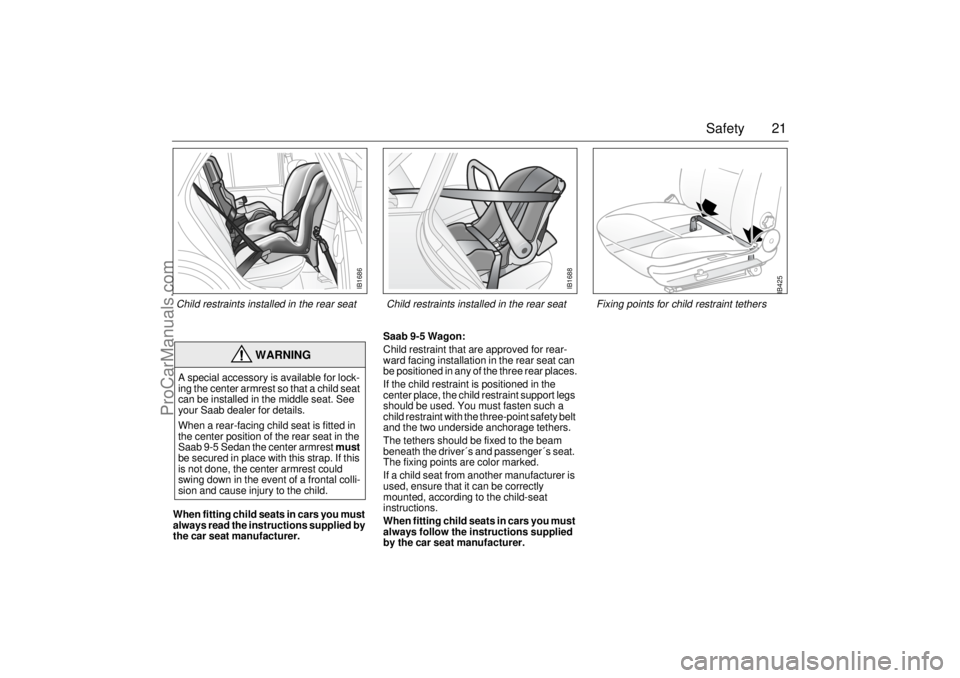
21 Safety
When fitting child seats in cars you must
always read the instructions supplied by
the car seat manufacturer.Saab 9-5 Wagon:
Child restraint that are approved for rear-
ward facing installation in the rear seat can
be positioned in any of the three rear places.
If the child restraint is positioned in the
center place, the child restraint support legs
should be used. You must fasten such a
child restraint with the three-point safety belt
and the two underside anchorage tethers.
The tethers should be fixed to the beam
beneath the driver´s and passenger´s seat.
The fixing points are color marked.
If a child seat from another manufacturer is
used, ensure that it can be correctly
mounted, according to the child-seat
instructions.
When fitting child seats in cars you must
always follow the instructions supplied
by the car seat manufacturer.
WARNING
A special accessory is available for lock-
ing the center armrest so that a child seat
can be installed in the middle seat. See
your Saab dealer for details.
When a rear-facing child seat is fitted in
the center position of the rear seat in the
Saab 9-5 Sedan the center armrest must
be secured in place with this strap. If this
is not done, the center armrest could
swing down in the event of a frontal colli-
sion and cause injury to the child.
IB1686
IB1688
IB425
Child restraints installed in the rear seat Child restraints installed in the rear seat Fixing points for child restraint tethers
ProCarManuals.com
Page 22 of 272
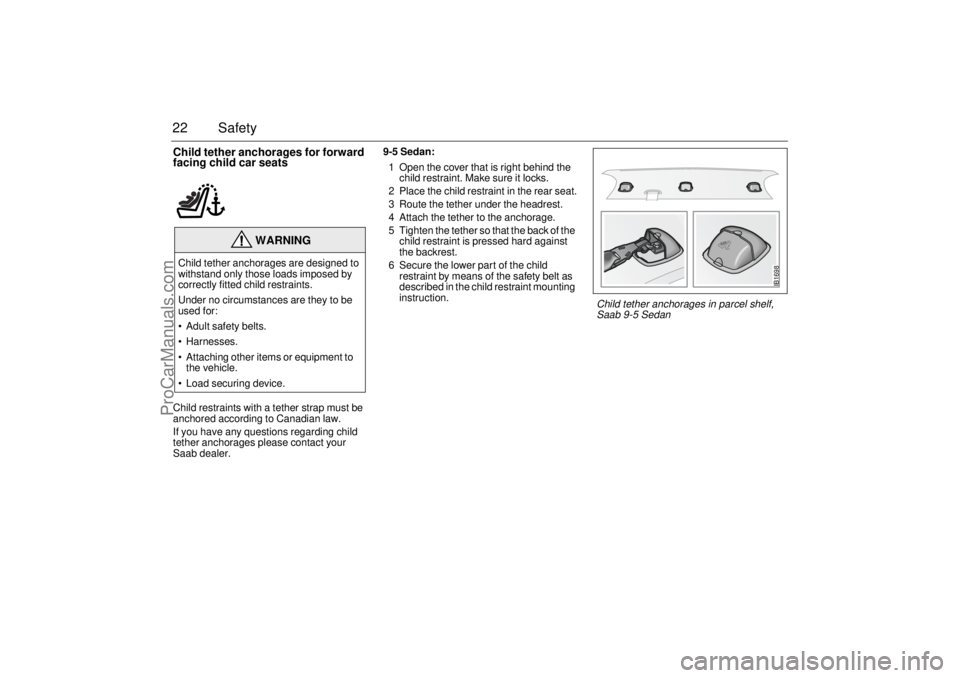
22 SafetyChild tether anchorages for forward
facing child car seatsChild restraints with a tether strap must be
anchored according to Canadian law.
If you have any questions regarding child
tether anchorages please contact your
Saab dealer.9-5 Sedan:
1 Open the cover that is right behind the
child restraint. Make sure it locks.
2 Place the child restraint in the rear seat.
3 Route the tether under the headrest.
4 Attach the tether to the anchorage.
5 Tighten the tether so that the back of the
child restraint is pressed hard against
the backrest.
6 Secure the lower part of the child
restraint by means of the safety belt as
described in the child restraint mounting
instruction.
WARNING
Child tether anchorages are designed to
withstand only those loads imposed by
correctly fitted child restraints.
Under no circumstances are they to be
used for:
Adult safety belts.
Harnesses.
Attaching other items or equipment to
the vehicle.
Load securing device.
IB1698
Child tether anchorages in parcel shelf,
Saab 9-5 Sedan
ProCarManuals.com
Page 26 of 272
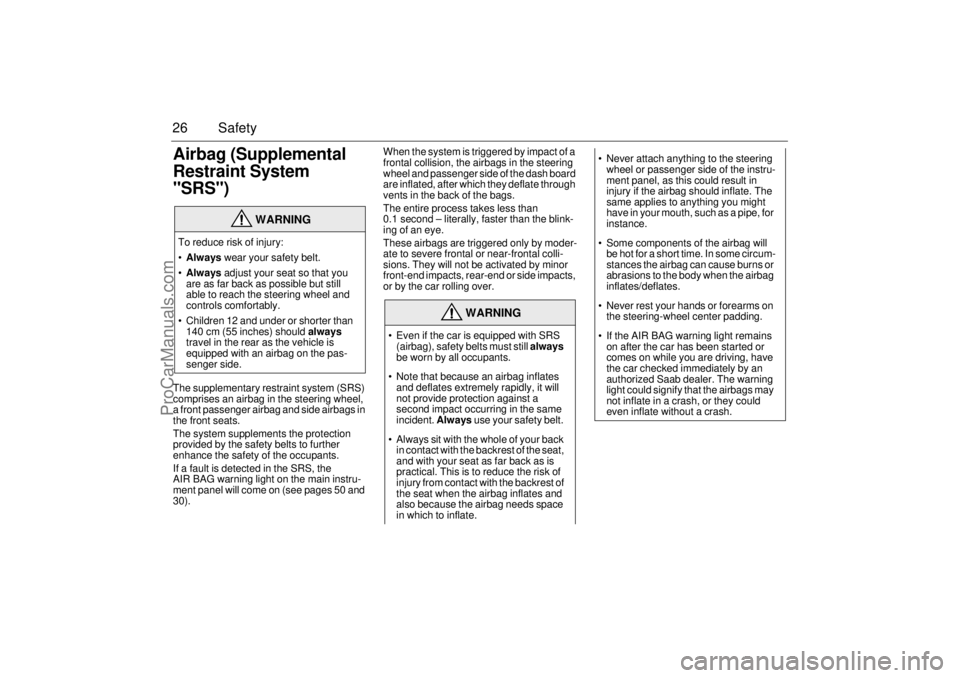
26 SafetyAirbag (Supplemental
Restraint System
"SRS") The supplementary restraint system (SRS)
comprises an airbag in the steering wheel,
a front passenger airbag and side airbags in
the front seats.
The system supplements the protection
provided by the safety belts to further
enhance the safety of the occupants.
If a fault is detected in the SRS, the
AIR BAG warning light on the main instru-
ment panel will come on (see pages 50 and
30). When the system is triggered by impact of a
frontal collision, the airbags in the steering
wheel and passenger side of the dash board
are inflated, after which they deflate through
vents in the back of the bags.
The entire process takes less than
0.1 second – literally, faster than the blink-
ing of an eye.
These airbags are triggered only by moder-
ate to severe frontal or near-frontal colli-
sions. They will not be activated by minor
front-end impacts, rear-end or side impacts,
or by the car rolling over.
WARNING
To reduce risk of injury:
Always wear your safety belt.
Always adjust your seat so that you
are as far back as possible but still
able to reach the steering wheel and
controls comfortably.
Children 12 and under or shorter than
140 cm (55 inches) should always
travel in the rear as the vehicle is
equipped with an airbag on the pas-
senger side.
WARNING
Even if the car is equipped with SRS
(airbag), safety belts must still always
be worn by all occupants.
Note that because an airbag inflates
and deflates extremely rapidly, it will
not provide protection against a
second impact occurring in the same
incident. Always use your safety belt.
Always sit with the whole of your back
in contact with the backrest of the seat,
and with your seat as far back as is
practical. This is to reduce the risk of
injury from contact with the backrest of
the seat when the airbag inflates and
also because the airbag needs space
in which to inflate.
Never attach anything to the steering
wheel or passenger side of the instru-
ment panel, as this could result in
injury if the airbag should inflate. The
same applies to anything you might
have in your mouth, such as a pipe, for
instance.
Some components of the airbag will
be hot for a short time. In some circum-
stances the airbag can cause burns or
abrasions to the body when the airbag
inflates/deflates.
Never rest your hands or forearms on
the steering-wheel center padding.
If the AIR BAG warning light remains
on after the car has been started or
comes on while you are driving, have
the car checked immediately by an
authorized Saab dealer. The warning
light could signify that the airbags may
not inflate in a crash, or they could
even inflate without a crash.
ProCarManuals.com
Page 28 of 272

28 SafetyFront passenger seat The airbags are interconnected and have a
common warning light. The passenger
airbag module is housed in the fascia above
the glove compartment and is marked ”SRS
AIRBAG”.
Both airbags will be inflated in the event of a
moderate to severe frontal, or near-frontal
collision, even if the passenger seat is unoc-
cupied.
Side airbags Side airbags are housed inside the back-
rests of the front seats and are designed to
protect the driver and front passenger in the
event of a side impact.
In a side impact, only the airbag on that side
will be activated, and only then if certain pre-
determined conditions are met such as the
force and angle of the impact, the speed of
the car on impact, and at which point on the
car’s side the impact occurs.
The sensors, which are fitted in the front
doors, sense the rise in pressure caused by
the door panel being pressed in during an
impact condition. The side airbag trigger will
be commanded based on the characteris-
tics of this pressure rise.
WARNING
Never secure a rear-facing child seat in
the right front seat of a car equipped with
a passenger airbag. Inflation of the airbag
in the event of an accident could seriously
injure or kill a child.
WARNING Children 12 and
under can be killed by
the airbag
The back seat is the
safest place for children
Never allow a child to stand in front of
the seat or to sit on the lap of a
front-seat passenger. Serious injury or
death could result if the airbag is
inflated in a collision.
Never place anything on the dash or in
front of the seat as, in addition to being
a hazard to passengers, this could
interfere with the function of the airbag
in the event of an accident. The same
applies to the mounting of accessories
on the dash.
Keep feet on the floor - never put feet
up on the fascia, on the seat or out of
the window.
Do not carry anything in your lap.
IB420
Passenger airbag and driver’s airbag both
inflated
ProCarManuals.com